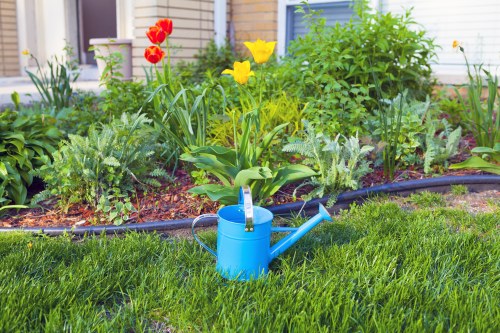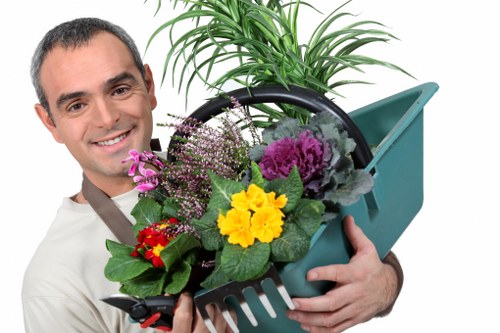Comprehensive Guide to Garden Maintenance in Canary Wharf

Maintaining a beautiful garden in the bustling area of Canary Wharf can be a rewarding yet challenging endeavor. Whether you are a seasoned gardener or a novice, understanding the unique demands of urban gardening in this financial hub is essential for creating a serene outdoor space.
Canary Wharf offers a unique blend of modern architecture and green spaces, making it an ideal location for garden enthusiasts. However, the urban environment presents specific challenges such as limited space, pollution, and varying weather conditions.
Effective garden maintenance in Canary Wharf requires a strategic approach that combines traditional gardening techniques with innovative solutions tailored to urban settings. This guide explores the best practices, tips, and services available to help you achieve a lush and vibrant garden.

Understanding the Climate and Soil in Canary Wharf
The climate in Canary Wharf is characterized by mild winters and warm summers, with occasional rainfall throughout the year. This climate influences the types of plants that can thrive in local gardens.
Soil quality is another critical factor. Urban soils can often be compacted and low in nutrients due to construction activities and heavy foot traffic. Conducting a soil test can help determine the necessary amendments to improve soil health.
By selecting plants that are well-suited to the local climate and soil conditions, gardeners can ensure that their gardens remain healthy and resilient throughout the year.

Essential Tools and Equipment for Garden Maintenance
Basic Gardening Tools
Having the right tools is fundamental to effective garden maintenance. Essential tools include:
- Pruning shears: For trimming and shaping plants.
- Garden gloves: To protect hands from thorns and soil.
- Watering can or hose: For providing necessary hydration to plants.
- Hand trowel: Ideal for planting and weeding.
- Lawn mower: For maintaining grassy areas.
Advanced Equipment
For more extensive garden maintenance, additional equipment may be required:
- Rototiller: To prepare large areas of soil for planting.
- Leaf blower: For clearing debris and leaves.
- Greenhouse: To extend the growing season and protect plants.
- Composting bins: For recycling organic waste and enriching soil.
Investing in quality tools can enhance efficiency and make garden maintenance tasks more manageable.

Regular Maintenance Tasks
Consistent maintenance is key to a thriving garden. Regular tasks include:
- Watering: Ensure plants receive adequate moisture, especially during dry periods.
- Weeding: Remove unwanted plants to reduce competition for resources.
- Pruning: Trim dead or overgrown branches to promote healthy growth.
- Fertilizing: Apply appropriate fertilizers to replenish soil nutrients.
- Pest Control: Monitor and manage pests to prevent damage to plants.
By adhering to a regular maintenance schedule, gardeners can prevent common issues and maintain the overall health of their garden.

Choosing the Right Plants for Urban Gardens
Selecting plants that thrive in urban environments is crucial for successful garden maintenance in Canary Wharf. Consider the following:
Native Plants
Native plants are well-adapted to the local climate and soil conditions, making them easier to maintain and more resilient against pests and diseases.
Low-Maintenance Varieties
Opt for plants that require minimal care, such as drought-tolerant species, to reduce the time and effort needed for maintenance.
Vertical Gardening
Utilize vertical spaces with climbing plants or trellises to maximize the limited area available in urban settings.
By carefully selecting suitable plants, gardeners can create a vibrant and sustainable garden that complements the urban landscape of Canary Wharf.

Seasonal Garden Care
Spring Maintenance
Spring is the perfect time to prepare your garden for the growing season. Tasks include:
- Clearing debris and fallen leaves.
- Pruning trees and shrubs to encourage new growth.
- Planting new flowers and vegetables.
- Checking and repairing garden tools.
Summer Care
During the summer months, focus on:
- Regular watering, especially during dry spells.
- Mulching to retain soil moisture.
- Controlling weeds and pests.
- Harvesting ripe produce in vegetable gardens.
Autumn Preparation
As temperatures cool, prepare your garden by:
- Raking fallen leaves and composting them.
- Planting bulbs for spring blooms.
- Pruning perennials and removing spent flowers.
- Protecting plants from early frosts.
Winter Maintenance
Winter tasks include:
- Protecting sensitive plants with mulch or coverings.
- Planning and designing garden layouts for the coming year.
- Maintaining garden tools and equipment.
- Monitoring for winter pests and diseases.

Hiring Professional Garden Maintenance Services
Benefits of Professional Services
While DIY garden maintenance is possible, hiring professionals offers several advantages:
- Expertise: Professionals have the knowledge and skills to tackle complex gardening tasks.
- Time-Saving: Outsourcing maintenance frees up your time for other activities.
- Quality Results: Experienced gardeners ensure your garden looks its best.
- Customized Services: Tailored maintenance plans meet the specific needs of your garden.
Choosing the Right Service Provider
When selecting a garden maintenance service in Canary Wharf, consider the following:
- Reputation and reviews from previous clients.
- Range of services offered.
- Pricing and value for money.
- Availability and flexibility of schedules.
- Certifications and qualifications of the team.
By carefully evaluating your options, you can find a reliable service provider that meets your garden maintenance needs.
Questions to Ask Potential Providers
Before hiring, ask the following questions:
- What specific services do you offer?
- Do you provide customized maintenance plans?
- What are your rates and payment terms?
- Can you provide references or testimonials?
- How do you handle pest and disease control?
These questions help ensure you choose a professional who aligns with your gardening goals.

Eco-Friendly Garden Maintenance Practices
Sustainable Gardening Techniques
Adopting eco-friendly practices not only benefits the environment but also promotes a healthier garden. Consider the following techniques:
- Composting: Recycle organic waste to create nutrient-rich compost for your garden.
- Rainwater Harvesting: Collect and use rainwater for irrigation to conserve water.
- Native Planting: Use native species that require less water and are more resistant to local pests.
- Mulching: Apply mulch to retain soil moisture and reduce weed growth.
Organic Pest Control
Instead of relying on chemical pesticides, use natural methods to manage pests:
- Introduce beneficial insects like ladybugs and bees.
- Use neem oil or insecticidal soaps for targeted pest control.
- Remove affected plant parts to prevent the spread of pests.
- Encourage biodiversity to create a balanced ecosystem.
Energy-Efficient Practices
Implement energy-efficient practices such as:
- Using solar-powered lighting for garden pathways.
- Installing energy-efficient irrigation systems.
- Choosing low-energy tools and equipment.
These practices contribute to a sustainable garden while reducing your environmental footprint.

Enhancing Garden Aesthetics
Design and Layout
A well-designed garden enhances the visual appeal and functionality of your outdoor space. Key design elements include:
- Symmetry and Balance: Create a harmonious layout with balanced plant arrangements.
- Color Coordination: Choose plants with complementary colors to create a cohesive look.
- Texture and Contrast: Incorporate a mix of plant textures and forms for visual interest.
- Focal Points: Use features like statues, fountains, or unique plants as focal points.
Lighting and Accessories
Garden lighting and accessories add both functionality and charm:
- Install pathway lights for safety and aesthetics.
- Use garden lanterns or string lights to create a welcoming atmosphere.
- Incorporate decorative elements such as benches, birdbaths, and sculptures.
- Choose weather-resistant materials to ensure longevity.
Seasonal Decorations
Decorate your garden according to the seasons to keep it vibrant year-round:
- Spring: Plant colorful flowers and add decorative mulch.
- Summer: Incorporate bright blooms and outdoor furniture.
- Autumn: Use pumpkins, gourds, and fall foliage.
- Winter: Add evergreen plants and festive lights.

Common Challenges in Garden Maintenance and Solutions
Pest Infestations
Pests can severely impact the health of your garden. Effective solutions include:
- Regular monitoring to detect infestations early.
- Using natural predators like birds and beneficial insects.
- Applying organic pesticides as a last resort.
- Maintaining plant health to resist pest attacks.
Disease Management
Plant diseases can spread quickly in a garden. Preventative measures include:
- Choosing disease-resistant plant varieties.
- Ensuring proper spacing for air circulation.
- Practicing crop rotation in vegetable gardens.
- Removing and disposing of diseased plant material promptly.
Weed Control
Weeds compete with desirable plants for nutrients and water. Control strategies involve:
- Mulching to suppress weed growth.
- Hand weeding to remove weeds without harming plants.
- Using landscape fabric in garden beds.
- Applying organic herbicides when necessary.
Water Management
Proper water management ensures plants receive adequate moisture without overwatering. Tips include:
- Installing drip irrigation systems for efficient water use.
- Watering plants in the early morning to reduce evaporation.
- Using rain barrels to collect and store rainwater.
- Monitoring soil moisture levels regularly.

Innovative Trends in Garden Maintenance
Smart Gardening Technologies
The integration of technology in gardening is revolutionizing garden maintenance:
- Automated Irrigation Systems: Smart systems adjust water usage based on weather conditions.
- Garden Sensors: Monitor soil moisture, temperature, and light levels to optimize plant care.
- Mobile Apps: Provide gardening tips, track plant growth, and schedule maintenance tasks.
Sustainable Practices
There is a growing emphasis on sustainability in garden maintenance:
- Using recycled materials for garden structures and decorations.
- Implementing permaculture principles to create self-sustaining gardens.
- Promoting biodiversity by planting a variety of species.
Vertical and Rooftop Gardens
With limited space in Canary Wharf, vertical and rooftop gardens offer creative solutions:
- Living Walls: Vertical structures covered with plants that maximize space.
- Rooftop Planters: Utilize rooftop areas for growing vegetables, herbs, and flowers.
- Hanging Gardens: Use vertical hanging systems to add greenery without occupying ground space.
Edible Landscaping
Combining aesthetics with functionality, edible landscaping integrates food-producing plants into garden designs:
- Planting fruit trees and berry bushes.
- Incorporating vegetable beds and herb gardens.
- Using decorative containers to grow edible plants.

DIY Tips for Effective Garden Maintenance
Create a Maintenance Schedule
Organize your garden maintenance tasks with a schedule to ensure consistency and prevent tasks from being overlooked.
- List all necessary tasks.
- Assign specific times of the year for each task.
- Use reminders or gardening apps to stay on track.
Proper Pruning Techniques
Pruning helps maintain plant health and aesthetics:
- Remove dead or diseased branches.
- Prune to shape plants and encourage growth.
- Use sharp, clean tools to make precise cuts.
- Understand the specific pruning needs of each plant species.
Effective Composting
Composting enriches soil and reduces waste:
- Collect organic waste such as leaves, grass clippings, and kitchen scraps.
- Combine brown and green materials in the compost pile.
- Turn the compost regularly to aerate and speed up decomposition.
- Use the compost to improve soil structure and fertility.
Water Conservation Practices
Conserving water is essential, especially in urban gardens:
- Implement drip irrigation systems for targeted watering.
- Use mulch to reduce evaporation and retain soil moisture.
- Collect and reuse rainwater for garden irrigation.
- Choose drought-tolerant plants to minimize water usage.

Final Thoughts on Garden Maintenance in Canary Wharf
Maintaining a garden in Canary Wharf blends the beauty of nature with the efficiency of urban living. By understanding the local climate, selecting appropriate plants, and adopting sustainable practices, you can create a thriving garden that offers a peaceful retreat amidst the city's hustle and bustle.
Whether you choose to undertake garden maintenance yourself or hire professional services, prioritizing regular care and staying informed about the latest gardening trends will ensure your outdoor space remains vibrant and inviting throughout the year.
Ready to transform your garden? Contact us today to book your garden maintenance service and experience the best in urban gardening.

